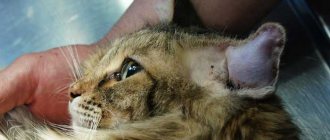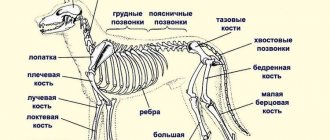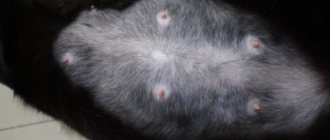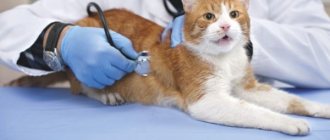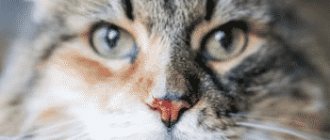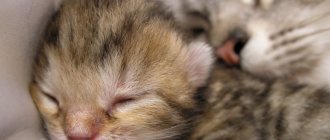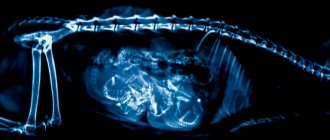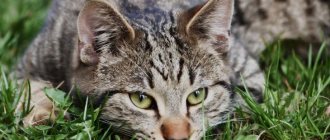Structural features
A cat's ears consist of three main sections:
- outer ear;
- average;
- internal.
This organ in such animals, as in most mammals, performs a dual function. Firstly, cats' ears are, of course, designed for hearing. This organ also allows animals to maintain balance and determine where is up and where is down.
American Curl
A wonderful breed of cats with small ears. The animals are very peaceful, have thick fur, which can be either short or long. The pets are active and love to play, they respond well to training, and can walk on a leash with their owner. They are distinguished by small ears with tassels, which makes cats recognizable.
The nature of the animals is flexible, they get along well with children, are unobtrusive, but enjoy playing with their owner. There is another interesting feature in the structure of a cat's ear. A photo of the animal shows how representatives of this breed have ears that curve outward, making the pets look unusual and even funny.
Auricle
The outer part of the cat's hearing organ, in turn, consists of:
- cartilage;
- entrance to the external auditory canal.
Since the shell of such pets is cartilage, it stands vertically in most cases. On the outside, the outer part of the cat's hearing organ is covered with short hair. The inside of the shell of furry pets is smooth and devoid of hair.
Cats' ears are able to rotate in the direction of the sound source. This is also why cats have excellent hearing. The ears of these animals are located on both sides of the upper part of the head. At the same time, cats are capable of turning them in different directions.
The most common ear problems
When examining the ears, you can identify some problems that pose a danger to the animal.
Ear mite
This manifests itself as ear scabies or otodecosis. The parasite settles in the ear canal and eats epithelial cells. It is impossible to detect it visually due to its microscopic size, but its vital activity is visible. Ear mites can be recognized by the following symptoms:
- restless behavior of the pet, he often waves his head, rubs it against various objects;
- actively scratches the ears until bloody marks appear;
- there is an unpleasant smell from the ear canal;
- inside the passage you can see a brown coating in the form of a crust.
In a particularly advanced state, the cat’s hearing acuity may even deteriorate. The drug Bars is an effective treatment. Only a veterinarian will give precise instructions for its use. Self-medicating can be dangerous for your pet.
Material on the topic: Abyssinian cats.
Otitis
This is an inflammation of the external auditory canal caused by bacteria. It is expressed by the following manifestations:
- purulent discharge with an odor from the ear;
- restless behavior;
- redness on the mucous membrane;
- The cat constantly scratches its ears and meows because of pain.
It is necessary to contact a veterinary clinic to get qualified help for this problem. Self-medication threatens hearing loss in the cat and deterioration of the animal’s condition.
Solar dermatitis
Albino animals that have low or no melatonin levels are susceptible to sunburn. At an early stage, the ear becomes redder, hair falls out, and the skin thickens.
Squamous cell carcinoma
Such a neoplasm can be triggered by sunlight. The skin of the ear canal may be affected. This disease appears as red spots or lumps.
Frostbite
In the cold, ear tissues, both external and internal, can be destroyed. The skin first turns red, then may turn black, and peeling begins. For any symptoms that may indicate a cat's health problems, you should seek professional help. This is the only way to prevent serious problems in the future.
Ear hematomas
When a cat begins to itch intensely and shake its head, its blood vessels burst, which causes hematomas to form. It may appear as small brown spots. Hematomas themselves cannot be treated; the main question is to eliminate the root cause that caused them.
When to clean your cat's ears
You can clean your cat's ears at home using improvised methods. There are two types of cleaning itself – preventive and therapeutic. The first type involves cleaning the sink from dust, dirt, and sulfur deposits. It is held every month. The frequency depends on the breed, diet, pollution rate and other individual characteristics of each individual.
Therapeutic cleaning is necessary when treating ear mites. For this purpose, special disinfectant liquids (antibiotics or antimycotics) are used. If your veterinarian has prescribed a specific treatment for your cat, you will first need to treat the ear with a saline solution or lotion. This is done before each administration of the drug.
Procedure for cleaning ears
What symptoms should you be wary of?
The following signs may indicate that a cat has ear problems:
- redness on the skin;
- the cat has hot ears;
- inflammation or swelling in the ear canal;
- dark or too light sulfur;
- discharge from the canal;
- smell;
- when pressing on the ear, strange sounds appear;
- partial hearing loss.
Habitual behavior may change if cats become stressed. She may itch severely and frequently, tilt her head to one side when a person tries to touch her ears, show aggression, or simply run away from him. If a cat's sulfur is black in color, this is due to the presence of blood in its composition. This most likely indicates ear mites. If the sulfur looks like scales and flakes off, we can talk about dermatitis. Diagnosing your pet and prescribing treatment without the advice of a veterinarian and examination by a specialist can be dangerous.
Cleaning a cat's ears
Anatomy of a cat's ear: structure of an acoustic tube
The opening of the auditory canal leading to the eardrum in such pets is located in the middle part of the base of the shell. The acoustic canal in cats is a cartilaginous hollow tube covered along its entire length with a leathery membrane. The latter, in turn, is capable of releasing sulfur. This substance is necessary for self-cleaning cats’ ears from foreign objects and dust.
In its lower part, the acoustic canal curves and connects with a hollow horizontal section ending in the eardrum. A special feature of the structure of cats' ears, among other things, is the high degree of protection of the acoustic membrane. There is no need to worry about damaging your pet's membrane when cleaning it, for example.
Middle ear
This part of the cat's hearing organ is located in the skull, in the temporal part. It is represented by three aurecal ossicles - the anvil, the malleus and the stirrup. Also part of a cat's middle ear are two muscles. The bones of these animals are connected to the snail. The middle ear of furry pets looks like a membranous tambourine. Vibrations from the membrane are transmitted to the bones and then enter the oval window of the cochlea.
The structure of cats' ears is such that they are able to capture vital sounds well. At the same time, too loud noise in the middle ear of such animals is muffled.
intimate ear
This part of the hearing organ in cats, like in other mammals, is a cochlea or labyrinth. The place of concentration of sound-receiving cells and various auxiliary structures is called the organ of Corti.
Sensory cells in cats are placed in liquid and protected on all sides by a filmy texture. Among other things, they have microscopic protrusions. It is the latter that perceive sound vibrations, and then transmit them to the receptors of the auditory nerves connected to the organ of Corti.
Any breed of cat has three microscopic semi-oval holes in the ear. These formations are filled with liquid and adjacent to each other at an angle. The main purpose of these holes is to balance and maintain balance for the animal. The vibrations of the liquid in them are captured by thin hairs and transmitted by them to the brain, which, in turn, records the position of the body in relation to the horizon.
Cat muscle structure and anatomy
A cat has 500 muscles - thanks to this number, it performs more acrobatic tricks than any professional acrobat can do. And they do this from birth.
There are 34 muscles on a cat's face, and 32 muscles on each ear.
Reference!
As many as 12 muscles are used to rotate one ear.
Cats also have well-developed muscles on their paws, which provide cats with the so-called “tiptoe walking” (about 1/5 percent of 40 muscles are involved).
The meowing muscles consist of two parts. Each muscle performs its own function: supporting or working.
The muscles of the cat family, like the muscles of other animals, work not only for movement, but also for muscle contraction, which allows them to accumulate their tone, and also allows them to fix joints in the correct position.
The active behavior of cats leads to the fact that muscle fibers begin to increase.
This process occurs due to hyperplasia (i.e., building muscle mass). And vice versa: a decrease in activity leads to hypertrophy (increase in fiber diameter).
Muscles are made up of fibers that contract under the influence of nerve impulses. For example, the cylindrical biceps brachii muscle contracts and thickens during elbow flexion and extension.
Each muscle has its own pair, the second of which is aimed at the opposite function of the first. Thanks to this mechanism, precise movements of the cat are made. In addition to locomotor functions, muscles also work to provide heat: heat is released due to muscle tremors.
The chest muscles, through contraction and relaxation, are used for the cat's breathing. The abdominal muscles work for bowel movements and childbirth, and also flex the spine when running. The muscles are also adapted for what was once one of the main functions of a cat - to catch prey and run away from the enemy. Cats are adapted for short distances. Even a cheetah will need rest after a short marathon.
Cat muscles are divided into three types depending on their location:
- Smooth muscles. They work independently, that is, supporting and controlling the work of internal organs.
- Striated muscles. Regulate the functioning of motor processes. The cat controls these muscles either consciously or out of instinct.
- The cardiac muscle is located in the heart. Controls the work of the heart.
Depending on the shape, muscles are:
- Lamellar - located on the head and entire body.
- Long, thick - located on the limbs.
- Sphincters - located at the edges of the openings.
- Combined muscles are made up of separate bundles (muscles of the spinal column).
Depending on the structure of the muscles there are:
- Dynamic – muscles that perform dynamic loads.
- Statodynamic - muscles that perform the function of static during support, hold the joints in an extended form when the cat is standing.
- Static muscles are muscles that carry a static load.
According to external action, muscles are divided into:
- Flexors (flexors).
- Extensors (extensors).
- Adductors (adduction).
- Abductors (abduction).
- Rotators (rotation).
The more developed the stroma, the more the muscles perform a static load. The shape of the abdominal muscles depends on the shape of the tendons.
Important!
Each muscle contains vessels that supply blood to the muscles and nerve endings. Muscles come in light and dark colors, and each muscle has its own specific function.
Absolutely all muscles are covered with special dense fibrous membranes - fascia. To prevent friction of muscles, tendons and ligaments, soften their contact with other organs (bone, skin), facilitate sliding during large ranges of movement, gaps are formed between the sheets of fascia, which are lined with a membrane that secretes mucus, or synovium, into the resulting cavity.
These formations are called mucous or synovial. These bursae can be located, for example, in the area of the elbow and knee joint. Damage to the bursa threatens damage to the joint.
Reference!
You might be interested to know why a cat moves its paws and purrs.
What shape can ears have?
The external auditory organ in most cat breeds is small in size and placed vertically. But in some breeds of these domestic animals the shell has an unusual shape. For example, the structure of the ears of Scottish cats can be called very original. In such animals, the shells are directed forward and seem to hang over the head, fitting quite tightly to it.
There are also breeds with large ears, such as Sphynxes. Curl cats have shells that are completely turned outward. In addition to color, a cat’s ears and tail are what mainly determine its belonging to a particular breed. In any case, no matter what shape the shell of such a pet has, its hearing will be simply excellent. The internal structure of the ears of such pets is the same.
Structure of a cat's ear
For representatives of the cat family, the ears are the main organ that helps them learn and perceive the world around them. They have incredible sensitivity - a cat can hear the sound made by a mouse's paws at a distance of up to 20 meters. Such a delicate mechanism requires very careful care. Any problems with the ears cause serious discomfort for your pet.
In cats of different breeds, the external hearing organs may differ in appearance. In some they are quite long and thin, in others they are small, slightly concave or hanging. No matter what animal ears look like, their structure is almost the same and resembles a human apparatus. There are 3 main components:
- The outer ear, consisting of the pinna and the auditory canal.
- The middle ear, which includes the eardrums and small auditory ossicles.
- The inner ear contains sensory structures and the vestibular apparatus.
The accumulation of dirt and earwax in these organs leads to hearing impairment and causes great inconvenience to the pet. Extremely short-haired breeds such as the Sphynx or Devon Rex require especially careful care. In such animals, earwax is produced more actively, and the resulting plugs put pressure on the ear canal. As a result, the cat may experience vestibular disorders, dizziness and migraines.
Otitis in a cat: symptoms
The causes of this disease can be injury, ear mites, water getting into the ear, etc. Otitis media in cats manifests itself primarily as itching and excessive secretion of wax. In this case, the animal constantly shakes its head. If the disease is localized in the middle or inner ear, a purulent exudant also appears in the cat's shell.
Otitis media can also be diagnosed by:
- unpleasant odor from the ears;
- high body temperature.
The ears of a cat with otitis media are usually hot. There is also a high probability of suspecting this disease in a pet if it has previously been diagnosed with otodectosis.
Treatment of otitis media
In order to alleviate the condition of a pet with this disease, it first needs to clean the sink of scabs and wax. For this purpose, it is best to use tampons soaked in your choice of:
- boric acid;
- peroxides;
- chlorhesidine;
- furatsilin;
- miramistine.
If there is a lot of pus in the cat’s ear or it is located deep, it would be better to take the animal to a veterinary clinic. The specialist will perform the procedure in this case, of course, with the highest quality possible.
To treat otitis media in cats, various types of drugs instilled into the ears can be used. A veterinarian should also prescribe such medications to an animal. The fact is that with otitis media, a cat's eardrum can become like a mesh. In this case, some types of drugs are contraindicated for furry pets.
Most often, the following types of drops are prescribed for instillation into the ears of cats for otitis media:
- "Otovedin."
- "Sofradex".
- "Aurican".
- "Tsipam."
- "Surolan".
For purulent otitis, such animals are also often prescribed antibiotics. These could be, for example, Erythromecin, Spiramycin, Cefazolin.
Cleaning a cat's ears - step-by-step instructions
- Position the cat so that it is positioned sideways to you and sit it on your lap. If necessary, grab it by the withers or wrap it in a towel;
- Carefully turn out the auricle and inspect its contents for the presence of dirt, inflammation and crusts;
- If you notice heavy discharge, take a swab and dip it in the chlorhexedine solution. Squeeze it out and walk along the inside of the ear, without pressing or going deep inside;
Gently lift the skin at the base to blot the surface of the ear with the swab
- If more wax has accumulated in your pet's ears, drop saline solution into the ear canal and massage it so that the liquid flows inside. After instillation, hold the cat for ten minutes to ensure that the solution has reached its target;
- If the solution used is in a bottle, then lower its tip two to three millimeters into the ear canal and squeeze out the required number of drops;
- When using cotton swabs, do not try to push them in as far as possible. In the inner ear, as a rule, wax does not accumulate due to the presence of the eardrum, therefore there is nothing special to clean “in depth”;
- When working with cotton swabs, make sure that your movements are directed outward and not inward, otherwise you will only push the sulfur deeper, from where it will be even more difficult to get it out;
Movements made with a cotton swab must be carried out according to strict rules
- When you are sure that the drops have successfully passed inside, wipe the animal's ears with a towel and reward him with a treat for his outstanding achievements.
Keep in mind that too frequent cleaning of your pet's ears leads to damage to the ear microflora, which is also fraught with various diseases. The frequency of cleanings depends on the breed and should be discussed with your veterinarian.
By the way! Hairless cats produce more earwax and require frequent cleaning.
Symptoms of ear dermatitis
This disease occurs quite often in cats. Ear dermatitis is a group of diseases characterized primarily by symptoms such as redness of the skin and rashes. The reasons for the development of this disease in cats can be, for example:
- parasites;
- allergy;
- injury;
- chemical or thermal burn.
Sometimes dermatitis occurs when an animal takes any medications uncontrolled. Any cat diseases should be treated in strict accordance with the veterinarian’s recommendations.
How to treat food dermatitis
It is as an allergic reaction to any food that this disease occurs most often in furry pets. The ears of both fold-eared cats and ordinary breeds can suffer from dermatitis. Unfortunately, no drugs have been developed that can cure food dermatitis in such animals once and for all. Owners of such a cat just need to carefully monitor what it eats and try to identify foods that cause a reaction. This is quite difficult to do, since quite a long time passes after eating and the first signs of allergic dermatitis. But with a little effort, you will most likely still be able to identify products that are unsuitable for your pet.
Breed Features
The Scots are different:
- In good health, with proper care, they can live up to 15 years or even more.
- A stable psyche.
- The animals are quite quiet, meowing very rarely.
- Due to their unusual shape, a cat’s ears (we discussed the structure in the article) are so small that they are almost invisible.
The first representatives of this breed were discovered in Scotland. The ancestors were simple domestic cats, and the folded ears appeared as a result of mutation. After birth, kittens have erect shells that are very small, but as the animal grows up, they acquire their own characteristic feature. Not all babies of this breed become lop-eared. During the first weeks, even an experienced breeder will not be able to predict their future appearance.
How to treat scabies
This disease is caused by mites that fall on the cat's skin through contact with other animals, birds, humans or any objects. To cure a pet, its shells must first be cleaned of scabs and dirt. The structure of a cat's ears is such that this procedure will be very easy.
At the next stage, the affected areas are lubricated with a special preparation. The type of product is chosen depending on the type of mite infesting the cat’s ears. For example, to treat scabies, drugs such as aversectin ointment 0.05%, creolin 3%, cydectin, etc. can be used.
To prevent the development of scabies, owners should limit their cat's contact primarily with stray cats. This is how the tick usually migrates from animal to animal. Owners of cat breeds with large ears should especially adhere to this recommendation. The area affected by such an animal can be very large, causing it to experience significant suffering.
Effective drugs for treatment
Now the range of drugs that could effectively fight ear mites is quite large. You can use drops, ointments, sprays, Acaromectin, Surolan, Oritsin, Bars, Otoferonol gold, Aversectin.
In addition to drugs whose action is aimed at combating parasites, anti-inflammatory, immunostimulating agents, as well as vitamin complexes are used.
Spray
This form of release is quite convenient to use. Acaromectin spray is used twice, with a break of 8-10 days. The main active component ivermectin has a detrimental effect on ticks.
It is prohibited to use on animals that are weakened, have suffered or have additional diseases.
Drops
This type of drug is no less effective. Drops are used that have different active substances, but they all have the same mechanism of action.
Applicable:
- Oricin is the active substance of ivermectin.
- Bars - diazinon.
- Otoferonol gold - deltamethrin.
- Surolan - miconazole.
Ointment
An equally popular form of release, which is used for effective treatment. Frequently used drugs include Aversectin ointment, the main active component is aversectin.
The course of treatment consists of two applications with a break of 5-7 days. This product should not be used by small kittens or pregnant animals.
Also, to cure otodecosis, Amidel-gel is used, in this case the effect is exerted by the active component amitraz, which is a potent acaricide. It also contains lidocaine, which helps relieve itching and pain.
Injections
This type of medicine is not used very often. Potent injections are often used when standard therapy does not bring results or the disease has become advanced.
Potent acaricides are used, for example, Ivermek, the mechanism of action of which is the production of butyric acid in the animal’s body; it is destructive for the parasite, but safe for the cat.
The product is prohibited for use on kittens, weakened pets, and pregnant and lactating women.
